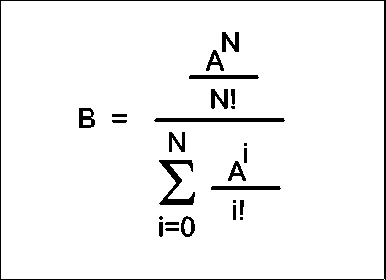Take the Sigma of a factorial with unknown variable (using sympy?)
Good day,
I am trying to write a function for the following equation:

Where B and N are given and I am solving for A.
I was reading up and it seemed like sympy was the way to go so I started to declare the known variables, but when it came to the sigma notation with the factorial, I had no idea of how to approach it since A is an unknown.
Here is what I came up with:
from sympy import Eq, var, solve
from math import *
A = var('A')
channels = raw_input("Enter the number of channels: ")
#GOS = raw_input("Enter GOS: ")
Sigma = A
for i in range(0,channels+1):
Sigma += (A**i / factorial(i))
# equation = Eq((A**channels / factorial(channels)) / Sigma)
# print solve(equation)
which gives me the error TypeError: cannot concatenate 'str' and 'int' objects
This makes sense to me, but my lack of knowledge with sympy makes me unable to figure out how to fix it.
EDIT: Looking around a bit more, I edited my code to this:
from sympy import *
A = symbols('A')
channels = raw_input("Enter the number of channels: ")
GOS = raw_input("Enter GOS: ")
Sigma = summation(A**i / factorial(i), (i, 0,channels))
print Sigma
# equation = Eq((A**channels / factorial(channels)) / Sigma)
Now I get NameError: name 'i' is not defined
Thanks in advance.
First of all, the error ( name 'i' not defined) is because you havent defined it. so you need to give an initial value for i.
secondly, I have tried to make your program run. got an error free solution with this code:
from sympy import *
A = symbols('A')
channels = raw_input("Enter the number of channels: ")
GOS = raw_input("Enter GOS: ")
# note that I convert the string 'channel' to an int
# convert to float if channel could also be a floating number
channels = int(channels)
Sigma = A
for i in range(0,channels+1):
Sigma += (A**i / factorial(i))
print Sigma
The result,
inputs: channels = 3, GOS = 1
output: A**3/6 + A**2/2 + 2*A + 1
EDIT: Out of interest I started looking further into your problem (also because I could realize this question would not stop just by a datatype issue). The Solve function has 2 inputs, the equation and the symbol to calculate. it solves the equation == 0. so the variable B has to be subtracted from the equation. (I supposed the input GOS is the B variable in the function)
equation = (A**channels / factorial(channels)) / Sigma
print(solve(equation-int(GOS), A))
running the code with the lines above (add them under the code) gave these outputs:
A**3/6 + A**2/2 + 2*A + 1
[-2 - sqrt(2), -2 + sqrt(2)]
I must notice that if the GOS does not intersect the function it gives large results with additional parameter I (capital i, might indicate imaginary i). I hoped this helped solving your problem.
- Unexpected list append
- Force matrix_world to be recalculated in Blender
- SQLAlchemy and empty columns
- ValueError: time data '24:00' does not match format '%H:%M'
- Convert RDD of LabeledPoint to DataFrame toDF() Error
- How to cancel trigonometric expressions in SymPy
- Get view used in Django tests
- Precompiled sasl python 3.9+ package for windows
- Regex: Substitute pattern in string multiple times without leftovers
- How to render raw html in the PyHTML library
- Why does my implementation of trilateration give wrong results?
- Django admin: how to sort by one of the custom list_display fields that has no database field
- TypeError: not all arguments converted during string formatting - psycopg2
- Is there a Python equivalent of the C# null-coalescing operator?
- Kraken API - Account balances request returning Invalid Nonce
- configparser without whitespace surrounding operator
- Pytorch tensor to numpy array
- Django: How to get a person whose birthday is today from a database?
- Performance impact of inheriting from many classes
- How can I do a line break (line continuation) in Python (split up a long line of source code)?
- Using pydantic to change int to string
- Breaking long method chains into multiple lines in Python
- What do ** (double star/asterisk) and * (star/asterisk) mean in a function call?
- How to install Pygame on Python 3.4?
- Rotating values in a list [Python]
- Launch default image viewer from pygtk program
- what's the inverse of the quantile function on a pandas Series?
- How can I install packages using pip according to the requirements.txt file from a local directory?
- Python generate all n-permutations of n lists
- FastAPI error when handling file together with form-data defined in a Pydantic model